May 19, 2006
We got up bright and early
and headed to the space center to meet up with Alan. My first order of business
was the mandatory visit to the visitor center gift shop, to buy a mission
T-shirt. This is easier said than done, though. The gift shop is embedded in the
"park", and you need to pay an entrance fee just to get to the shop (smart
design, I know). We were all hoping that my official badge would get me in
for free, as otherwise Alan would have to escort me in - and you can imagine how
hundreds of school kids would react to a real life astronaut. Fortunately, I
could get in; but once in the gift shop I soon realized that not much has
changed in the last 4 years since I've been here last time, not even the shirt
designs: I found only one new T-shirt that I would consider wearable, and that I
didn't own yet. Now that could be interpreted in more than one way, I just hope
you give me the benefit of the doubt.
Our first real stop was at the VAB perimeter, where we enjoyed the view of the
ET and the two boosters thru the already opened VAB door. After Alan talked to
the security personnel about the upcoming roll-out procedure, we picked up
George at the press site, piled all our gear into the van, not forgetting the
very important cooler full of water bottles (including lemon water, very much to
Jay's dismay) plus some nice big cookies (you don't want the chocolate to be
melting before it gets to your mouth, do you!) and headed to the inside of the
VAB, where the crawler was undergoing last minute preparations. We set up camp
on ground level where a crowd of employees was already gathered and watching.
Among them was Wayne Hale, the Shuttle Program Manager, and Dena Haynes, Camera
Project Manager. We had a nice chat with Dena about problems with cameras in
space, about issues that us Earth trapped fellows don't necessarily think about.
Conversation was difficult because there was already some loud noise, but we
were told that things were about to get much more fun - and were handed ear
plugs.
With a big cloud of smoke the diesel generators were started and the ear plugs
indeed came handy.
The crawler has two diesel engines, each producing 2750 HP.
The fuel consumption of these engines is 150 gallons / mile, and the fuel tank
is 5000 gallons in size. That makes your obese Hummer look like a hybrid in
comparison. These two engines produce electricity, and the crawler
is actually driven by 16 electric motors, just like a diesel locomotive. Two
additional 1065 HP engines provide the power needed for the crawler's hydraulic
systems and for cooling. While in operation, the crawler keeps about 30 people
busy, ranging from three drivers to engine mechanics and the guys watching the
tracks for any anomalies. There are eight tracked tread belts, each containing
57 shoes. Each shoe is 7.5x1.5 ft in size and weighs over 2000 lbs. So it comes
as little surprise that the top layer of gravel in the
seven foot
deep crawlerway gets totally crushed to powder; after all, the whole stack
together weighs about 6 million pounds (2750 metric tons).
The crawler picked up the last crew
members and soon we could observe
the drive shafts spinning slowly, then more quickly. At an almost imperceptible
speed the crawler started to move and head out into the sunshine. It took 50
minutes until the crawler had left the building, but unlike with Elvis, the show
was just getting started.
From the VAB we headed towards the
Launch Control Center, LCC, where we wanted
to watch the early phase of the roll-out from a balcony. A large crowd had
gathered in the LCC parking lot, but since we had an astronaut among us we were
guaranteed a premium parking spot. They don't give them free Corvettes anymore,
but a parking spot isn't something to sneeze at these days, either.
Click on the first image
to start a slide show for this day (60 pictures)
Images shown below are a small selection.
In slide show, click on image to return to index.
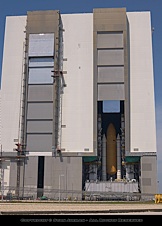 |
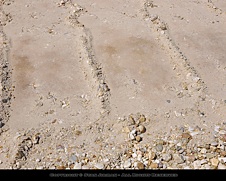 |
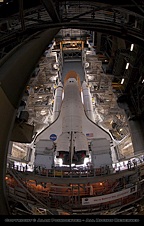 |
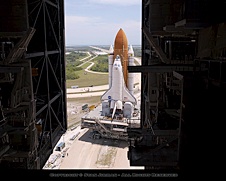 |
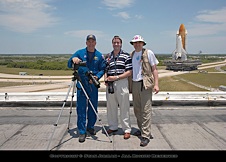 |
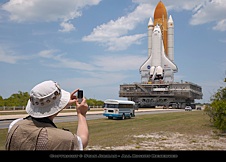 |
The view from the LCC
balcony was awesome; while we arrived a bit too late to have the crawler drive
by right in front of us, we still got a premium view of the stack heading
towards the launch pads at its full speed of 0.75 mi/hr. That doesn't sound like
too much, one can easily walk along like that; but if you want to take The
Perfect Picture you have to be at four places at pretty much the same time: the
VAB to catch the shuttle exiting; the LCC to see it from all angles driving by;
the press site to catch it with the water in the foreground; at "the tree" to
catch it with some interesting foreground (of which there isn't much around
here).
The VAB and LCC were behind us; we were too late for the water shot; so we
headed to The Tree. This was a simple yet strong composition, and as George
assured us, quite unique. It got even more powerful when the security helicopter
decided to land right in front of us. And while Jay and I used every camera at
our disposal to capture every fleeting moment before the shuttle slowly crept
away, Alan was once again posing for photographs with the ladies.
It was just around this time that the crawler suddenly stopped, due to what
later turned out to be an overheated bearing. It just needed some extra grease
and was fixed in 20 minutes. It wasn't a screeching
halt or anything of that sort - would be hard to do at that speed and with
millions of pounds of cargo; it merely calmly came to a standstill. Without much
hesitation we used this opportunity to approach the crawler and get some
close-up pictures; the size of this machine becomes truly apparent when you are
standing right next to it. But it didn't take too long and the crawler was
repaired, again on its way to 39B. Because the crawler was now on one of the two
long straights of its journey, we went to the cafeteria to get some food and to
download our memory cards.
After a quick lunch we headed back to the crawler, which was just about to make
a left turn towards pad 39B. We had a premium viewing position for this
spectacle - a gantry usually used by tourists to view the two launch pads. This
time the three of us had it all to ourselves, free of charge, shooting with the
sun - unlike the press guys in the old school bus, down by the turn, facing the
sun. We felt special.
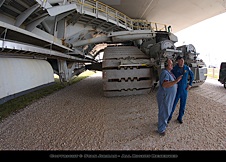 |
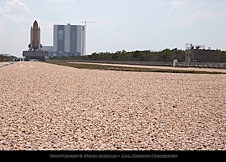 |
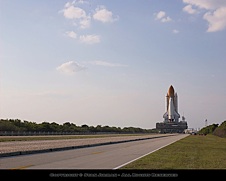 |
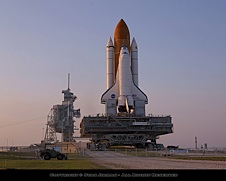 |
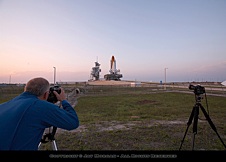 |
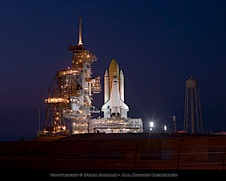 |
Once the shuttle had turned, it was a straight line all the way to the launch pad. That was where we set up camp for the next - and last - sequence. There would be other great places to shoot from, as George pointed out - a place further south of the pad where you could usually see the shuttle with its reflection in some water. However, Florida was suffering from a drought, I was told, and so instead of a pool of water all we could see was some cracked ground which doesn't reflect all too well. Drought or no drought, it was still hot and humid as I kept pointing out to my two Texan friends who clearly had no sympathy.
We just witnessed the main gate at the launch pad being pushed open by means of a small bulldozer - no space age garage door openers here. We set up our camera gear on the other side of the crawler way, once again going with the sun. The shuttle was coming closer and closer, at a reassuring slow pace, emitting constant loud noise from the locomotive engines. It was an amazing experience. Just as it entered the gate, halfway through, it stopped, as in preparation for the exhausting climb up the hill to the launch pad. There she stood, Discovery, right in front of us, glowing in the setting sun. Then the motion resumed at a very slow pace, and we could see the platform slowly lift itself in order to stay perfectly level while climbing up the hill to the pad. It's one thing to see this colossus moving in a straight line; to see it tilted, as if carrying the shuttle on one shoulder, is a whole new experience and makes you want to thank whoever invented hydraulics.
The crawler is guided to the launch pad (as it is over its entire trek from the VAB) via a laser guidance system which can navigate it with a precision of 1/8". With this precision Discovery arrived at launch pad 39B with last light of the day, and many NASA employees and contractors gathered around the launch pad fence and sentimentally looked at her, standing majestically at the pad, illuminated by a large array of lights. The only thing to interrupt the sentimental gasps was the frantic swatting of mosquitoes, which have emerged by the millions at sunset from the swamps around the cape and which were relentlessly harassing anyone brave or stupid enough to be outside. Always use protection, kids! The frantic swatting continued even once we piled back into the van, which we left with all doors open for easy access.
We had witnessed an amazing journey that lasted just around 8 hours. For Alan it may have been just another day at the office - no wonder he loves his job. For Jay, myself and all the other people lucky enough to have been here today, it was a day to remember forever.